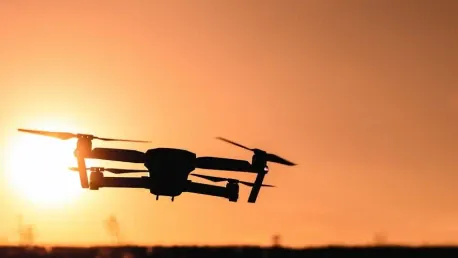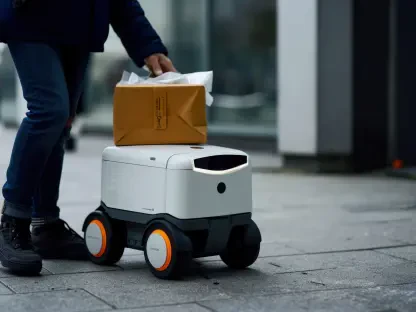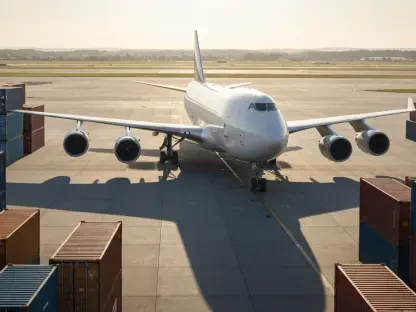The retail and logistics sectors are on the verge of a major transformation, one that promises to reshape how goods are transported and delivered worldwide. Central to this change is the adoption of drone deliveries, offering a glimpse into the future where efficiency and innovation drive the supply chain. According to a new PwC report titled “Drone Deliveries: Taking Retail and Logistics to New Heights,” the widespread utilization of drones for deliveries is not just a possibility but an imminent reality. This article explores the transformative potential of drone deliveries, examining its economic, operational, and environmental implications for businesses and consumers.
Emerging Trend: Drone Deliveries
Rapid Growth and Adoption
Drone deliveries are poised to become a dominant force in logistics. According to the PwC report, by 2024, around 14,000 daily drone deliveries are anticipated. These figures are expected to skyrocket to 808 million annual deliveries by 2034, illustrating the rapid integration of drones within the delivery ecosystem. This growth is driven by technological advancements, regulatory support, and growing consumer demand for quicker and more efficient delivery options.
The exponential increase in drone deliveries marks a significant milestone in the logistics sector, highlighting the necessity for businesses to adapt quickly to the changing landscape. The shift from traditional modes of delivery to drone technology promises not only speed but also a reduction in transportation costs. Consequently, businesses that invest in drone technology stand to gain a competitive edge, streamlining their operations while meeting the growing demand for speedier delivery services. As drones become more commonplace, we can expect to see innovative applications across various sectors, from retail to healthcare, further emphasizing the need for a robust and adaptable logistical framework.
Integration into Supply Chains
The seamless integration of drones into existing supply chains will be vital. Drones offer the ability to bypass traditional infrastructure, making deliveries directly from warehouses to consumers’ doorsteps, particularly advantageous in hard-to-reach or congested urban areas. Businesses will need to re-evaluate their logistics strategies and adopt a more flexible, agile approach to accommodate drone technology. This shift will likely lead to the emergence of new logistical hubs and innovative delivery networks.
For instance, urban delivery centers may see a shift from central warehouse locations to more strategically placed drone hubs, facilitating faster and more efficient delivery routes. Moreover, the ability to circumvent traffic congestion and other logistical bottlenecks means that businesses can offer more reliable and timely delivery services, enhancing overall customer satisfaction. As companies explore the possibilities of drone integration, we can anticipate a more interconnected and dynamic supply chain system capable of responding rapidly to market demands and consumer expectations.
Economic Impact
Service Available Market (SAM) and Total Market Potential (TAM)
The economic implications of drone deliveries are profound. The PwC report forecasts that the SAM value of goods delivered by drones will surge from 251 million USD in 2024 to a staggering 65.2 billion USD by 2034. Moreover, the TAM could reach 389 billion deliveries globally. These figures highlight the potential to disrupt current supply chains, reducing costs and improving service delivery, particularly in markets with high logistical barriers.
The financial benefits of drone deliveries extend beyond mere cost reduction. By enhancing delivery efficiency and reliability, businesses can improve their overall service quality, leading to increased customer retention and satisfaction. Furthermore, the ability to reach markets that are geographically isolated or have limited infrastructure opens up new business opportunities, contributing to revenue growth. The forecasted economic impact underscores the importance of strategic investments in drone technology and infrastructure to capitalize on the potential market expansion and cost savings.
Cost Efficiency and Market Penetration
Drone delivery costs are expected to significantly decrease, potentially as low as two USD per unit by 2034. This reduction in cost makes drone deliveries a viable and competitive alternative for last-mile delivery services. By reaching up to 67% of the global population by 2034, drones will open up new markets, particularly in suburban and rural areas where traditional delivery services are less efficient. This widespread adoption is likely to enhance business profitability and customer satisfaction.
The affordability of drone deliveries is a game-changer for businesses looking to optimize their last-mile delivery operations. With lower delivery costs, companies can pass on savings to consumers, making goods more accessible and affordable. Additionally, the increased reach of drone deliveries enables businesses to tap into underserved markets, creating new revenue streams and expanding their customer base. As the technology matures, we can expect further cost reductions and improvements in delivery efficiency, making drones an indispensable tool in modern logistics.
Business Integration and Sectoral Influence
Impact on Retail Chains and Logistics Companies
Retail chains, logistics companies, and restaurant chains stand to benefit immensely from drone deliveries. By leveraging drone technology, these businesses can create new sales channels and reach additional clients, significantly boosting last-mile delivery efficiency. This transition could also lead to reduced capital expenditure, as businesses optimize their operations and expand their reach without the need for extensive traditional infrastructure.
The potential for cost savings and operational efficiency makes drone technology an attractive investment for businesses across various sectors. For retail chains, drones can facilitate faster restocking of shelves and quicker delivery of online orders, enhancing the overall shopping experience. Logistics companies can optimize their delivery routes and reduce fuel consumption, leading to lower operational costs and a smaller environmental footprint. Restaurant chains can offer faster food deliveries, improving customer satisfaction and increasing order volumes. The integration of drones into these businesses’ operations promises to drive innovation and set new standards for service delivery.
Transformative Effects on Different Sectors
The adoption of drone technology is set to transform various sectors. For instance, grocery stores could provide faster home deliveries, while e-commerce platforms could offer near-instantaneous shipping. This level of efficiency and speed can drastically alter consumer expectations and drive further innovation within these industries. Businesses that proactively embrace drone technology will likely gain a competitive edge and set new standards for service delivery.
In healthcare, drones can be used to deliver medical supplies and medications to remote or underserved areas, ensuring timely access to essential healthcare services. In agriculture, drones can facilitate the quick and efficient delivery of seeds, fertilizers, and other supplies, optimizing farming operations and improving crop yields. The transformative potential of drone deliveries is vast, with applications extending beyond traditional retail and logistics. As businesses explore the possibilities of drone technology, we can expect to see new and innovative uses emerge, further driving the adoption and integration of drones across various sectors.
Technological Advancements and Tool Innovation
The PwC Drone Delivery Location Finder
One of the critical technological advancements highlighted in the PwC report is the PwC Drone Delivery Location Finder. This geospatial analysis tool is designed to identify optimal locations for drone deliveries by analyzing a multitude of variables, including regulatory, operational, environmental, and market conditions. These insights help businesses deploy drones strategically, maximizing efficiency and coverage.
The PwC Drone Delivery Location Finder offers a comprehensive approach to planning and optimizing drone delivery operations. By considering factors such as airspace restrictions, population density, and weather patterns, the tool provides businesses with valuable insights to make informed decisions. This strategic deployment ensures that drones can operate safely and efficiently, minimizing disruptions and maximizing delivery performance. As companies adopt this tool, we can expect to see more targeted and effective drone deployment strategies, enhancing the overall efficiency of the delivery network.
Overcoming Technological Challenges
Despite the promising potential, there are technological challenges that need to be addressed. Issues such as battery life, payload capacity, and navigation in diverse weather conditions are crucial areas for ongoing research and development. Innovations in these fields will be necessary to ensure that drones can operate reliably and safely, meeting the high standards required for commercial use.
Advancements in battery technology will be pivotal in extending the range and flight time of drones, enabling them to cover larger delivery areas without frequent recharging. Improvements in payload capacity will allow drones to carry heavier and more diverse types of goods, making them suitable for a wider range of delivery applications. Enhanced navigation systems, incorporating advanced sensors and artificial intelligence, will enable drones to operate safely and efficiently in various weather conditions and challenging environments. Addressing these technological challenges is essential for the widespread adoption and success of drone deliveries.
Challenges and Opportunities
Navigating Regulatory Landscapes
One of the significant hurdles to widespread drone adoption is the regulatory landscape. Different countries have varying regulations concerning drone operations, which can impact how quickly and effectively drones can be integrated into logistics networks. Companies will need to work closely with regulatory bodies to address these challenges and ensure compliance while pushing for regulatory frameworks that support innovation.
Navigating the regulatory landscape requires a proactive and collaborative approach. Businesses must engage in ongoing dialogue with regulatory authorities to understand and comply with existing regulations while advocating for policies that facilitate innovation and growth. Developing standardized regulations and operating procedures will be crucial in ensuring the safe and efficient integration of drones into the logistics ecosystem. As regulatory frameworks evolve, companies that stay ahead of compliance requirements and actively contribute to shaping industry standards will be better positioned to capitalize on the opportunities presented by drone deliveries.
Safety, Security, and Public Perception
Ensuring the safety and security of drone operations is paramount. Drones must be equipped with advanced navigation systems and fail-safes to prevent accidents. Additionally, public perception will play a crucial role in the adoption of drone deliveries. Companies must engage in public education and transparent operations to build trust and mitigate any concerns regarding privacy and safety.
Implementing robust safety protocols and security measures will be essential in gaining public trust and ensuring the safe operation of drones. This includes developing fail-safe mechanisms to handle system failures, implementing geofencing to restrict drone operations in sensitive areas, and conducting regular maintenance and inspections to ensure the reliability of the fleet. Public education campaigns can help alleviate concerns and highlight the benefits of drone deliveries, fostering a positive perception and encouraging adoption. By prioritizing safety, security, and transparency, companies can build a solid foundation for the successful integration of drones into their operations.
Environmental and Consumer Benefits
Sustainability and Environmental Impact
Drone deliveries align with the growing consumer demand for sustainable and environmentally friendly services. By reducing reliance on traditional delivery vehicles, drones contribute to lower greenhouse gas emissions and decreased traffic congestion. This shift towards greener delivery methods supports broader environmental goals and resonates with eco-conscious consumers.
The environmental benefits of drone deliveries extend beyond reduced emissions. Drones operate on electric power, eliminating the need for fossil fuels and further reducing the carbon footprint of delivery operations. Additionally, the ability to optimize delivery routes and avoid traffic congestion means that drones can operate more efficiently, minimizing energy consumption and environmental impact. As consumers become increasingly aware of environmental issues, the demand for sustainable delivery options will continue to grow, making drone deliveries an attractive proposition for forward-thinking businesses.
Enhancing Consumer Experience
The integration of drone deliveries enhances the overall consumer experience by offering faster, more reliable, and more convenient delivery options. For time-sensitive deliveries, such as medical supplies or perishable goods, drones provide a rapid and efficient solution. This level of service can significantly enhance customer satisfaction and loyalty, driving repeat business and positive word-of-mouth.
Moreover, the novelty and innovation associated with drone deliveries can create a unique and memorable customer experience. The ability to track deliveries in real-time and receive goods directly by drone adds an element of excitement and convenience that traditional delivery methods cannot match. As businesses continue to refine and expand their drone delivery capabilities, consumers can expect a new standard of service that prioritizes speed, reliability, and sustainability.
Future Insights and Geopolitical Factors
Preparing for Widespread Adoption
The PwC report suggests that companies should prepare for the widespread adoption of drone deliveries. The report’s insights and tools, like the PwC Drone Delivery Location Finder, offer valuable guidance for businesses aiming to stay ahead in a rapidly evolving market. Companies must invest in the necessary infrastructure, technology, and expertise to seamlessly integrate drones into their logistics operations.
By staying informed about industry trends and developments, businesses can make strategic decisions that position them for success in the drone delivery landscape. This includes exploring partnerships with technology providers, investing in research and development, and training staff to manage and operate drone fleets. As drone technology becomes more advanced and accessible, businesses that proactively adapt their operations and strategies will be best positioned to capitalize on the opportunities presented by drone deliveries.
Geopolitical Influences on Drone Deliveries
The geopolitical landscape, especially in regions like Central and Eastern Europe, plays a significant role in shaping the drone delivery ecosystem. Countries like Poland and Romania are identified as potential logistics hubs, particularly in light of geopolitical shifts such as Ukraine’s reconstruction.
Geopolitical factors can influence regulatory environments, trade policies, and infrastructure development, impacting the feasibility and success of drone deliveries in different regions. Businesses must stay attuned to these factors and adapt their strategies accordingly. By understanding and leveraging geopolitical opportunities, companies can establish a strong presence in emerging markets and navigate potential challenges effectively.
The retail and logistics industries are on the brink of a significant transformation, heralding a new era in the transport and delivery of goods on a global scale. Central to this revolution is the integration of drone technology into delivery systems, offering a promising look into the future where efficiency and innovation pervade the supply chain.
A recent PwC report titled “Drone Deliveries: Taking Retail and Logistics to New Heights” indicates that the widespread use of drones for deliveries is no longer a mere possibility but an approaching reality. The article delves deeply into the game-changing potential of drone deliveries, analyzing their economic, operational, and environmental impacts on businesses and consumers alike.
From an economic perspective, drone deliveries could reduce costs significantly. Operationally, drones can navigate challenging terrains more efficiently than traditional methods, ensuring quicker and more reliable service. Environmentally, drones offer a greener alternative by minimizing carbon emissions compared to conventional delivery vehicles.
As companies adopt this technology, the way goods are transported will evolve, making logistics smarter and more efficient. This shift promises not only to enhance consumer experiences but also to set a new standard in sustainability and operational efficiency. The retail and logistics sectors are thus poised to embrace a future where drone deliveries play a pivotal role in reshaping the global supply chain landscape.









